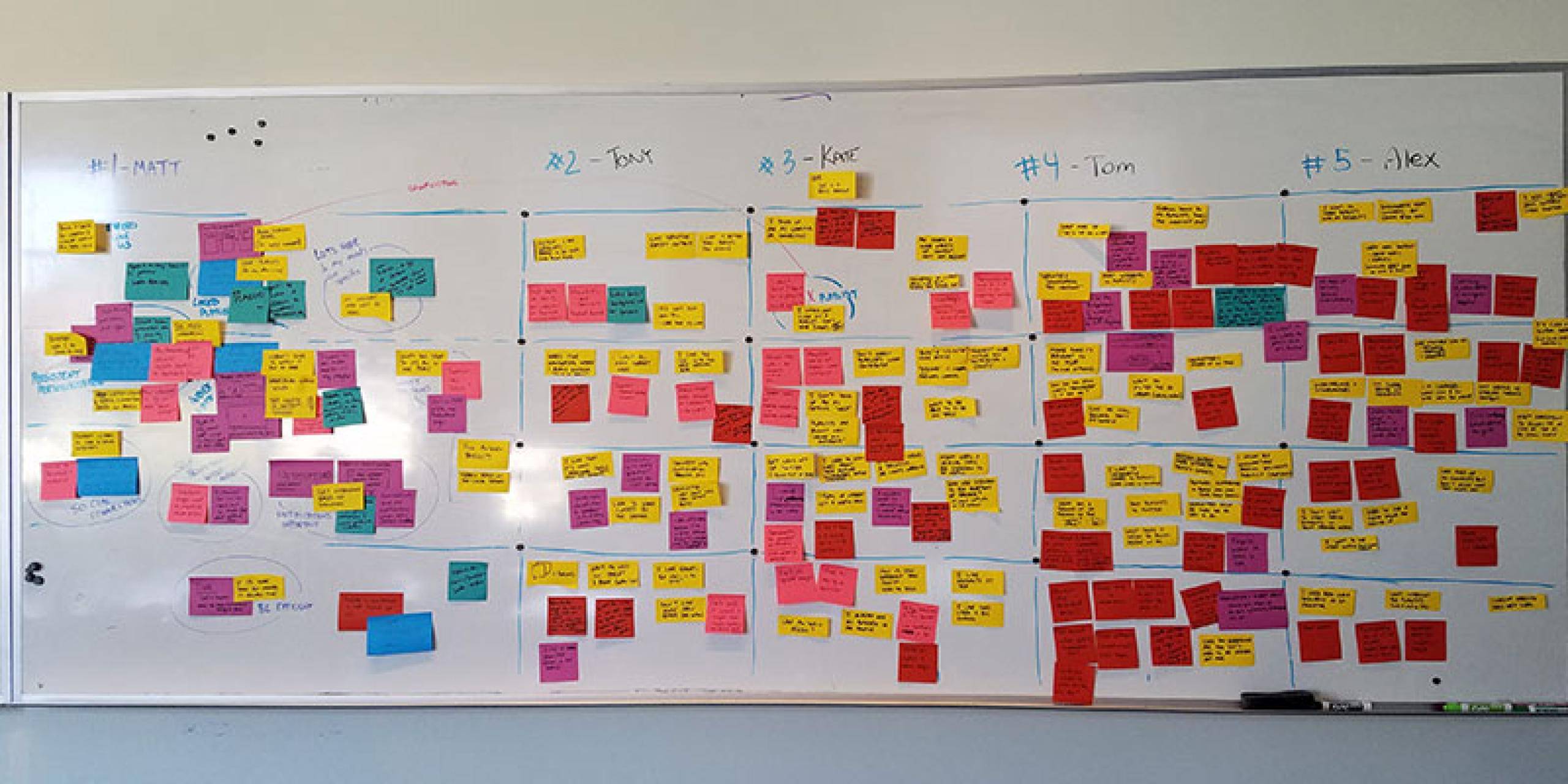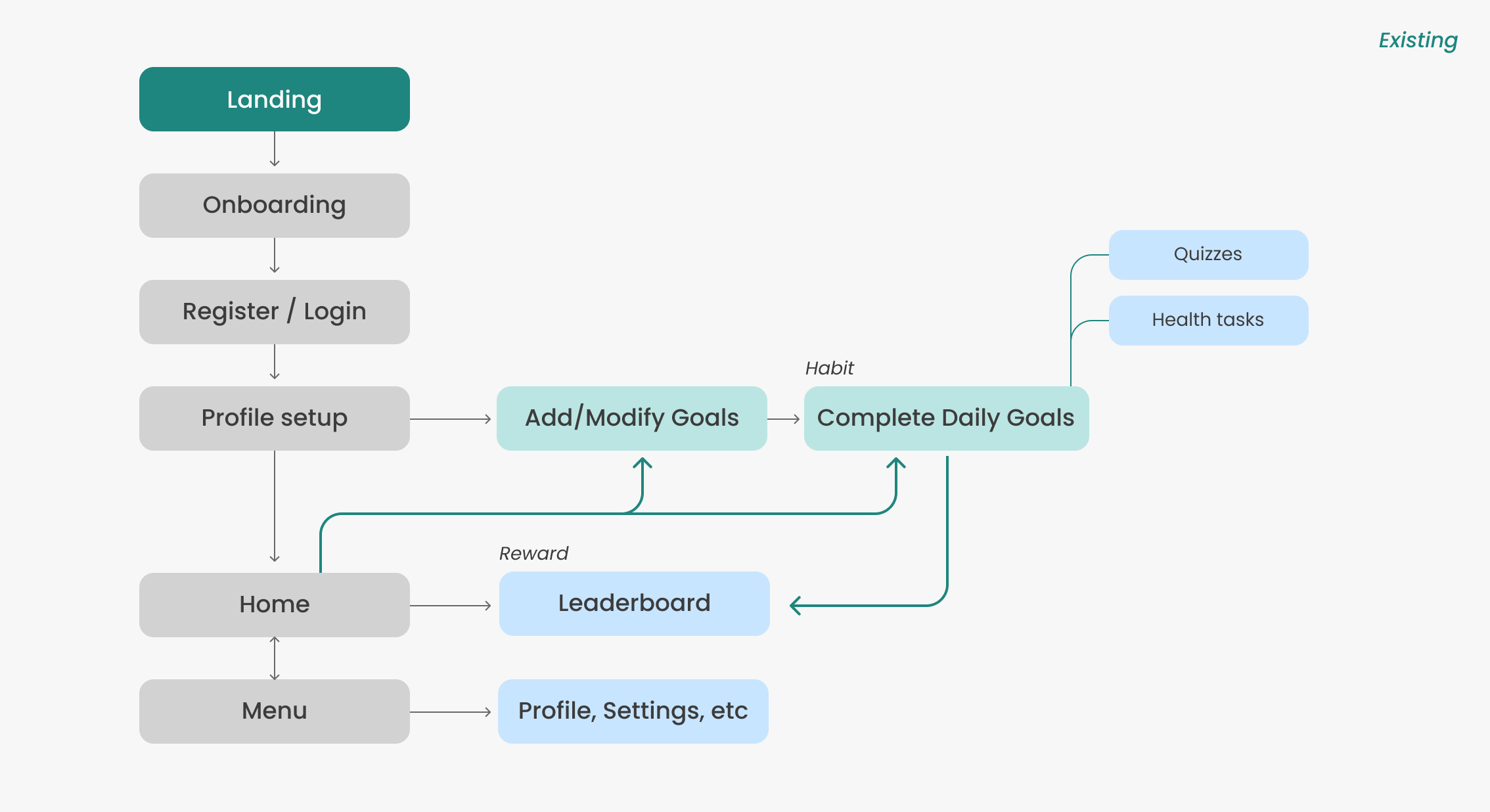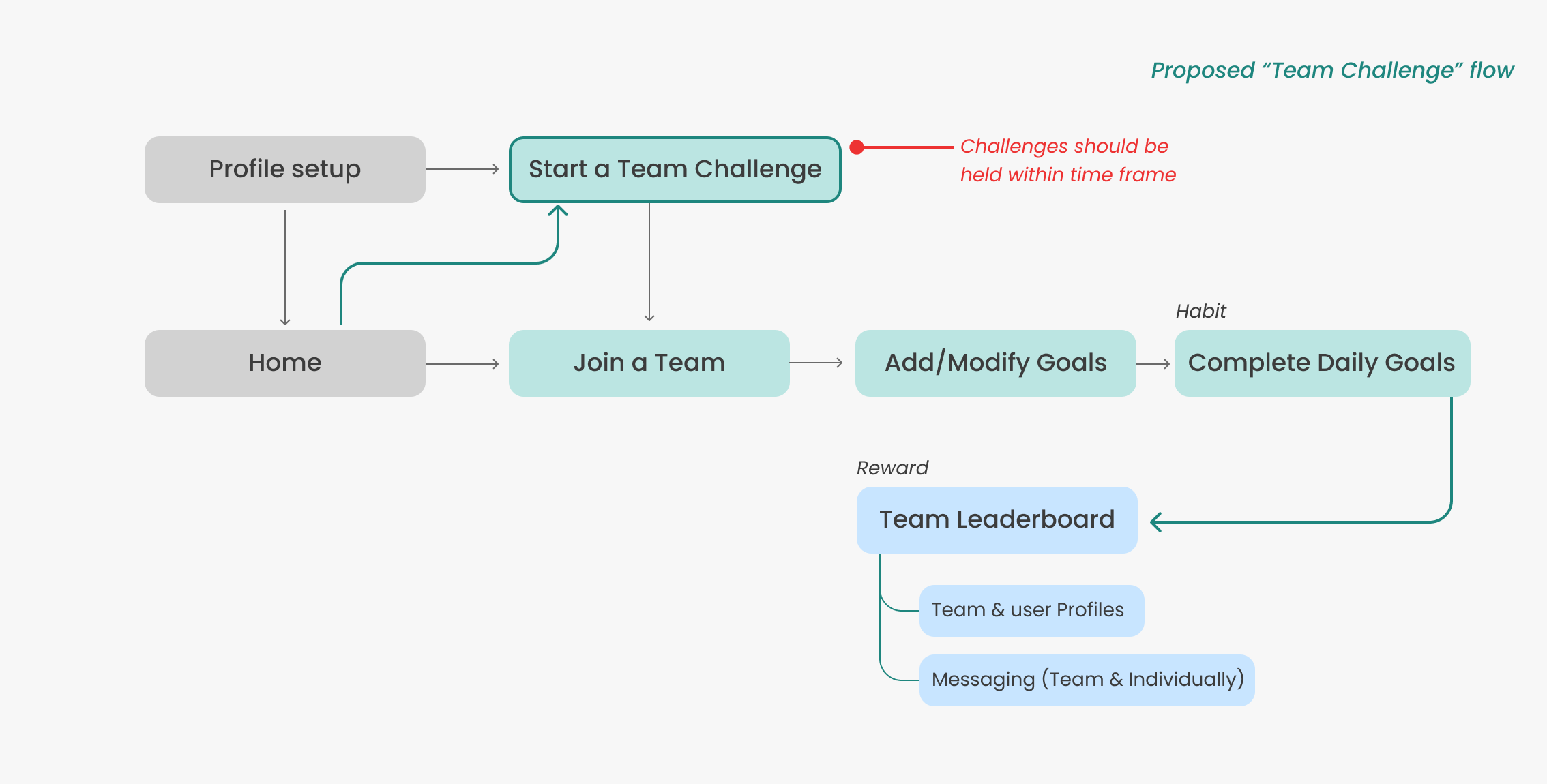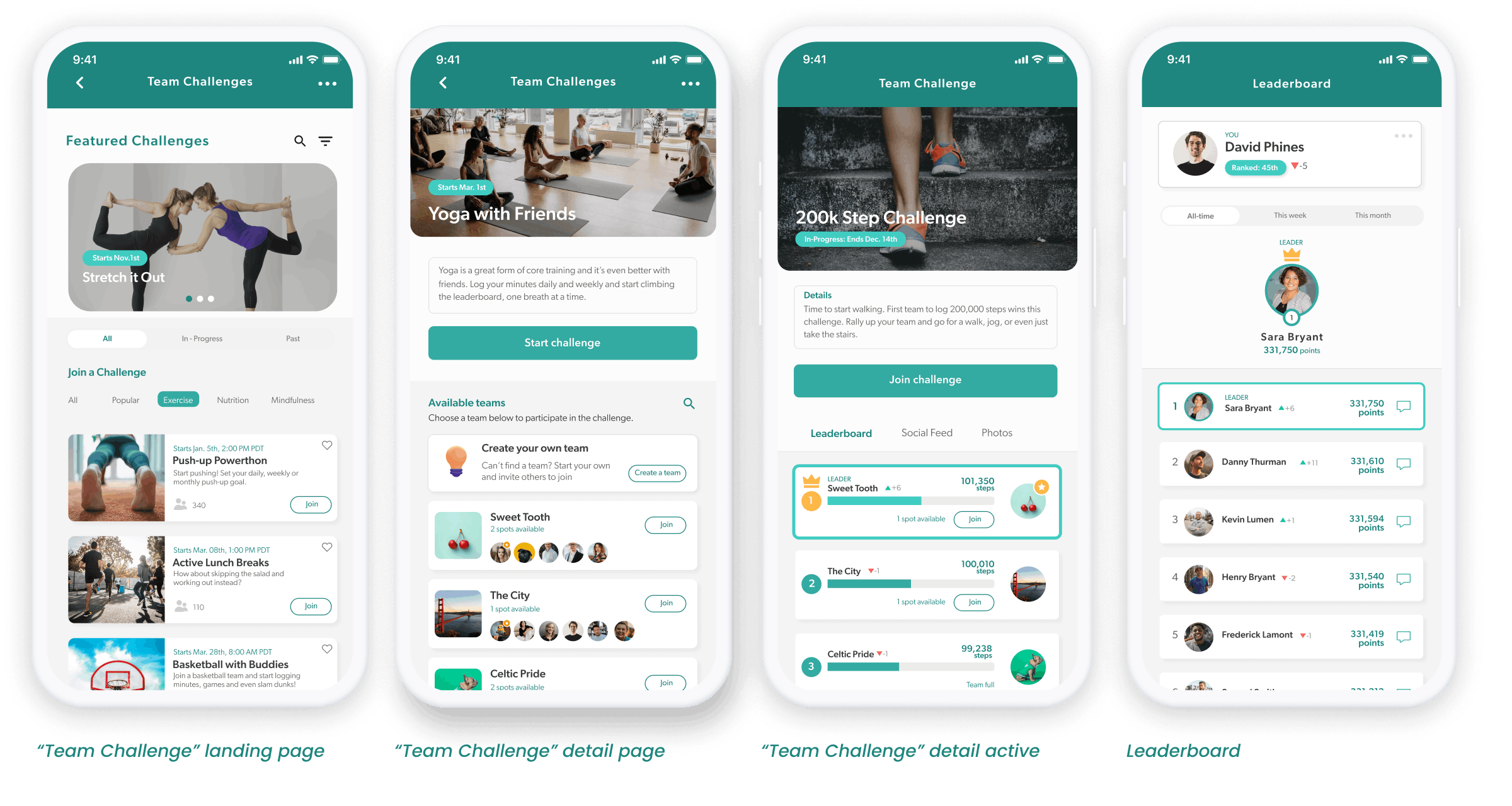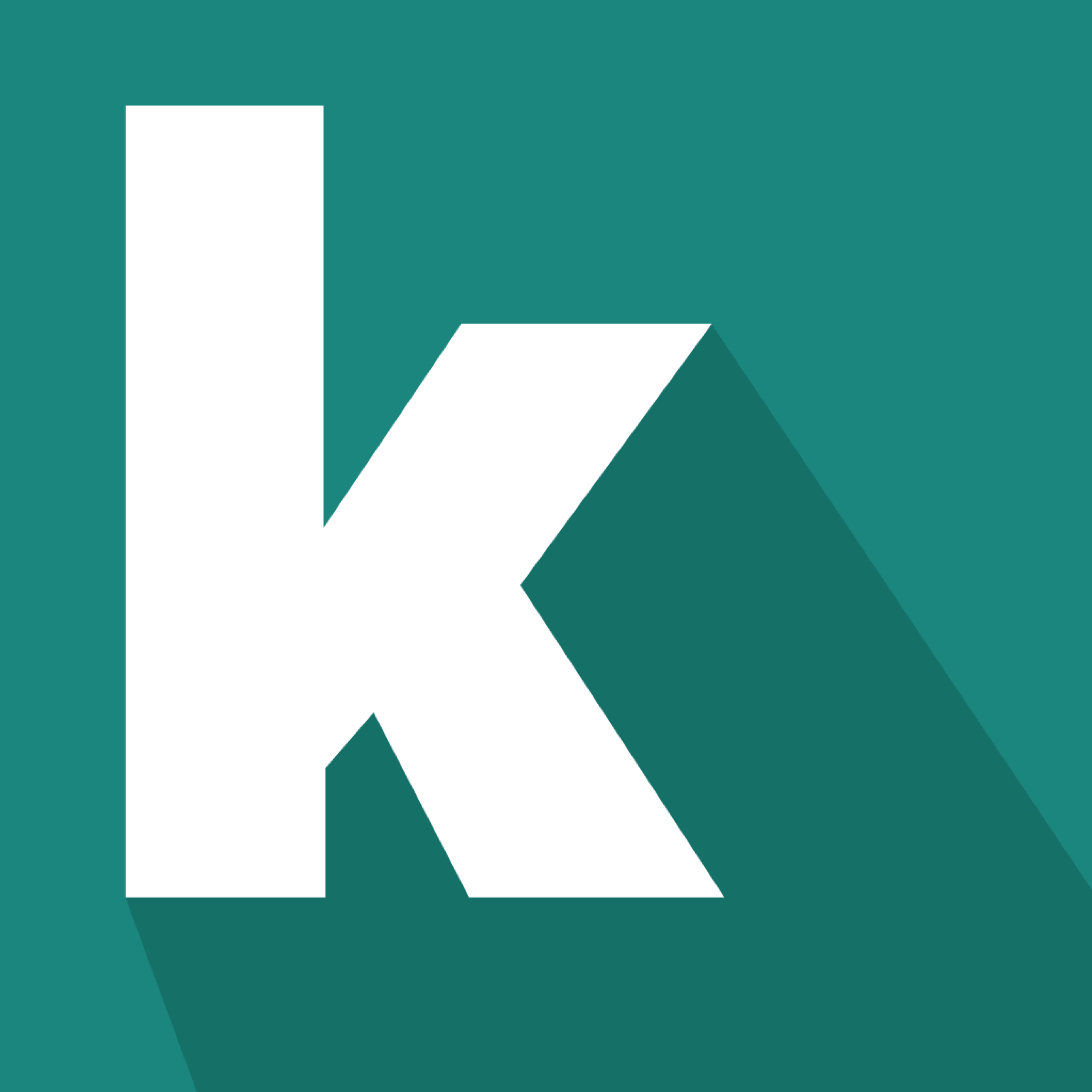
Keas Team Challenge In-App Experience
Role: UX Design
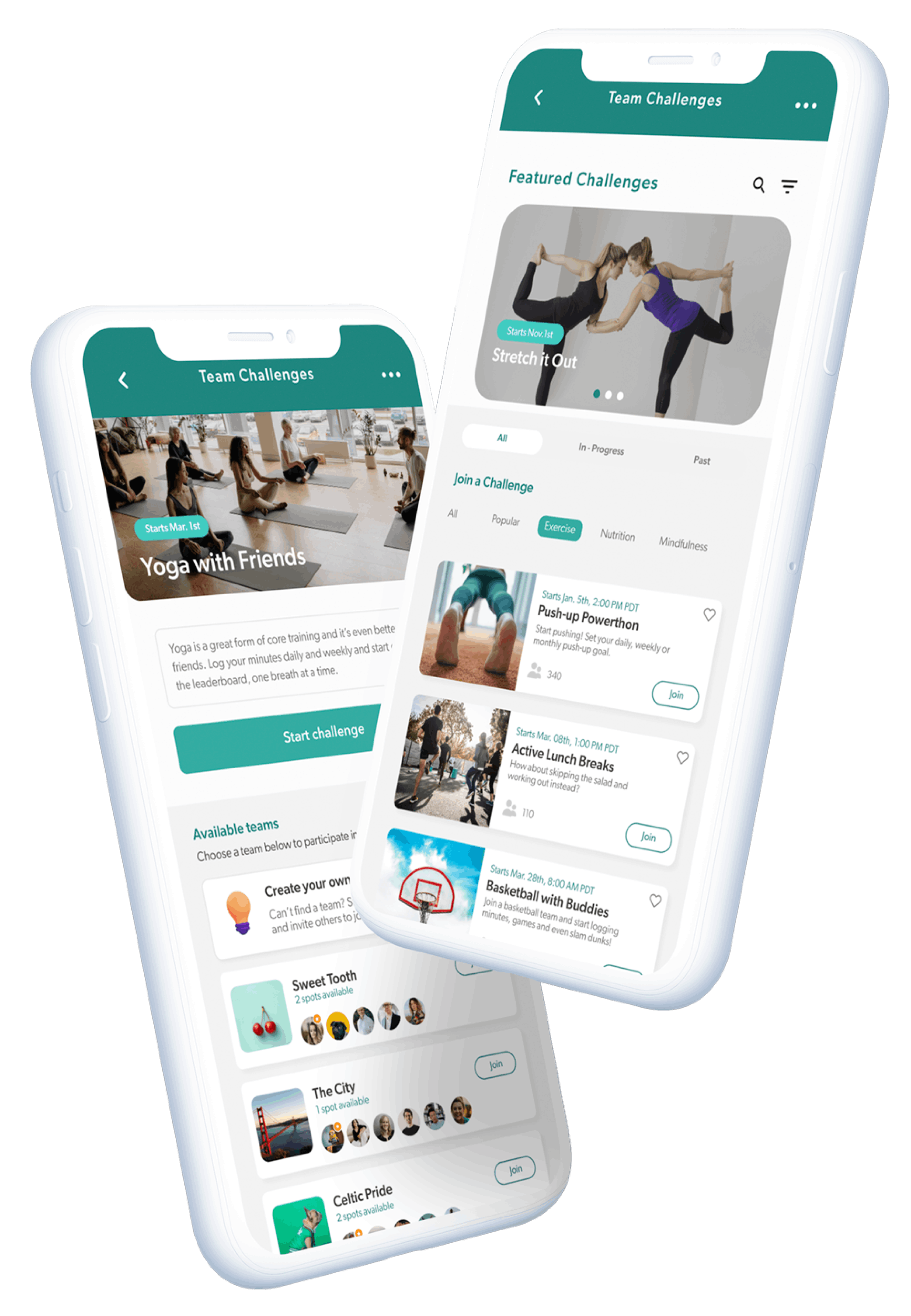
Overview
Keas (aquired by Welltok) mobile app enabled Fortune 500 employees to compete with each other in health incentive plans, participate in fitness activities, socialize and develop healthy habits.
My Role
As one of the junior UX designers on the team, I contributed to finding solutions to increase user engagement.
What I did:
Led quantitive and qualitative user research through interviews and data analysis.
Delivered user flows, wireframes, specs and annotations for dev teams.
Utilized rapid prototyping to iterate and validate ideas.
PROBLEM
One of Keas’ key challenges was keeping users engaged. Users accessed the app through wellness incentives provided by their employer. While most users onboarded and used the app in the first 2 weeks, user engagement dropped significantly afterwards.
“What features could we present to users to increase engagement on the Keas app?”
DISCOVER
To gain insight on how users engaged with the Keas app and where possible pain points existed, I conducted interviews with existing users. I also teamed up with customer service to check if we had any complaints or comments around the app. My objective in this stage was to discover what aspects of the apps lacked user engagement and find opportunities to improve the experience overall.
• User Interviews
• Surveys
DISCOVER
User Interviews Part 1
The first part of my research was sending out a set of pre-screener surveys and then following through with user interviews. The
interviews I set up were a set of questions while the user navigated their way through the app highlighting likes and dislikes.
Goals
Understand and observe what participants enjoyed and disliked about the Keas app.
Primary Research Questions
Q1.
What are your favorite parts about the
Keas app?
Keas app?
Q3.
What are your favorite features within
the Keas app?
Q2.
What are your biggest
frustrations when using the app?
frustrations when using the app?
Q4.
How often do you log-in and use
the Keas app?
the Keas app?
Survey
Responses
Responses
0
User
Interviews
Interviews
0
DISCOVER
User Interview Insights
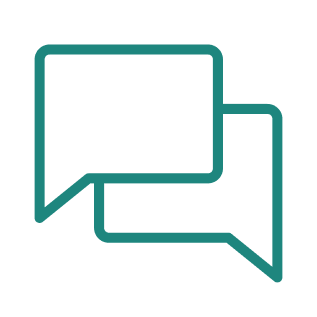
“Honestly after I complete my daily goals, take a quiz and log my activity there isn’t much left to do”

“I love that we can compete with other employees, but it’s unfortunate that I don’t know who most of them are”

“There’s really not much incentive to compete with others. Our company doesn’t offer any prizes to the winner”

“The leader board is pretty cool. I’ve learned that all you have to do is log in daily and you can rise to the top pretty easily ”
DISCOVER
User Interviews Part 2
The second part of my research focused more on qualitative insights. With the initial research, I observed how users engaged with the app, but little was mentioned around their health habits. I wanted to learn more around how our current users engaged in exercise, fitness and overall health.
Goals
Understand how users approach exercise, fitness, nutrition and overall healthy habits.
Primary Research Questions
Q1.
What activities do you do in order to stay healthy?
Q3.
How often do you engage in any form of exercise?
Q2.
What motivates you to lead a healthy lifestyle?
Q4.
What do you enjoy and dislike the most about exercise?
DISCOVER
User Interview Insights 2

“It’s hard to find motivation to exercise, but if I do have a reason to like a vacation, I’m pretty determined to get in shape”

“I don’t know how some people like to go on walks solo. I love going on walk with a friend or my husband.”

“As long as I know I’m making at least one healthy decision a day, I feel good about it.”

“I hate jogging but could play hours of pick-up basketball with others. ”
DEFINE
After both rounds of interviews , I proceeded to synthesize the feedback and data collected from users. More importantly, I wanted to look for any common themes in the data that might help me define the engagement problem at hand.
• Affinity Maps
• Insights
DEFINE
Affinity Map Insights
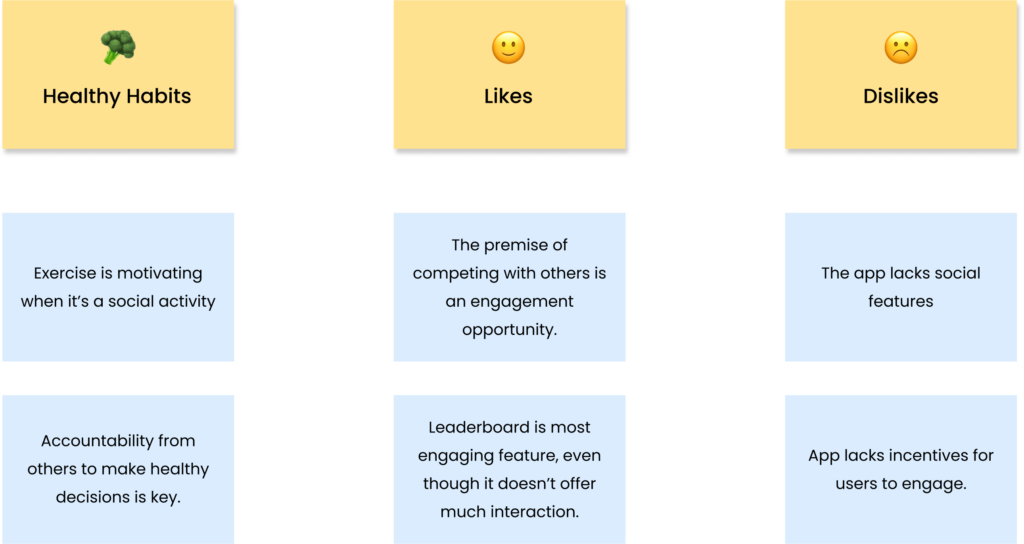
DEFINE
Key Findings

Exercise works best when it becomes socially motivated
Most users I interviewed described how exercise and healthy habits worked best when friends or peers participated. Taking some accountability when engaging in healthy habits seemed to motivate individuals.
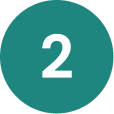
Keas app lacks social engagement
One of Keas’ primary goals was to create healthy habits. However, content and features within the app, lacked engagement with other users. Most habit forming tasks were solely individual.
IDEATION
Moving forward, I wanted to explore possible solutions around the two insights I found during research. I knew there were opportunities within the social aspect of my findings along with how our users engaged in healthy habits like exercise and nutrition.
• “How Might We”
• Concepts
• Usability Testing
IDEATION
"How Might We" 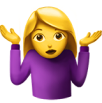
Help users engage with others to maintain healthy habits like exercise and nutrition.
IDEATION
The Hook Model
I focused my attention on the leaderboard, which had been mentioned in the interviews. I thought it was an area to explore more in-depth, being that it was the only feature that showcased other active users.
Areas of Opportunities
- Users profiles were not visible / actionable
- No messaging or interactions between users
- Leaderboard was based on individual’s performance, no teams available.

IDEATION
Team Challenge Concept 
Leveraging my findings around motivation, habits and engagement, I wanted to explore concepts around teams. Keas users had a very individualistic approach when using with the app. There was absolutely no social engagement. I wanted to begin exploration around how to get users more socially engaged at a team level when using the app.
IDEATION
Lo-Fi Wireframes
After a few rounds of l sketches, I began constructing lo-fi wireframes. My main goal during this stage was to begin adding components and layout to see if designs matched flows. I focused on the primary elements I needed for the flows and designs to be a simple as possible.
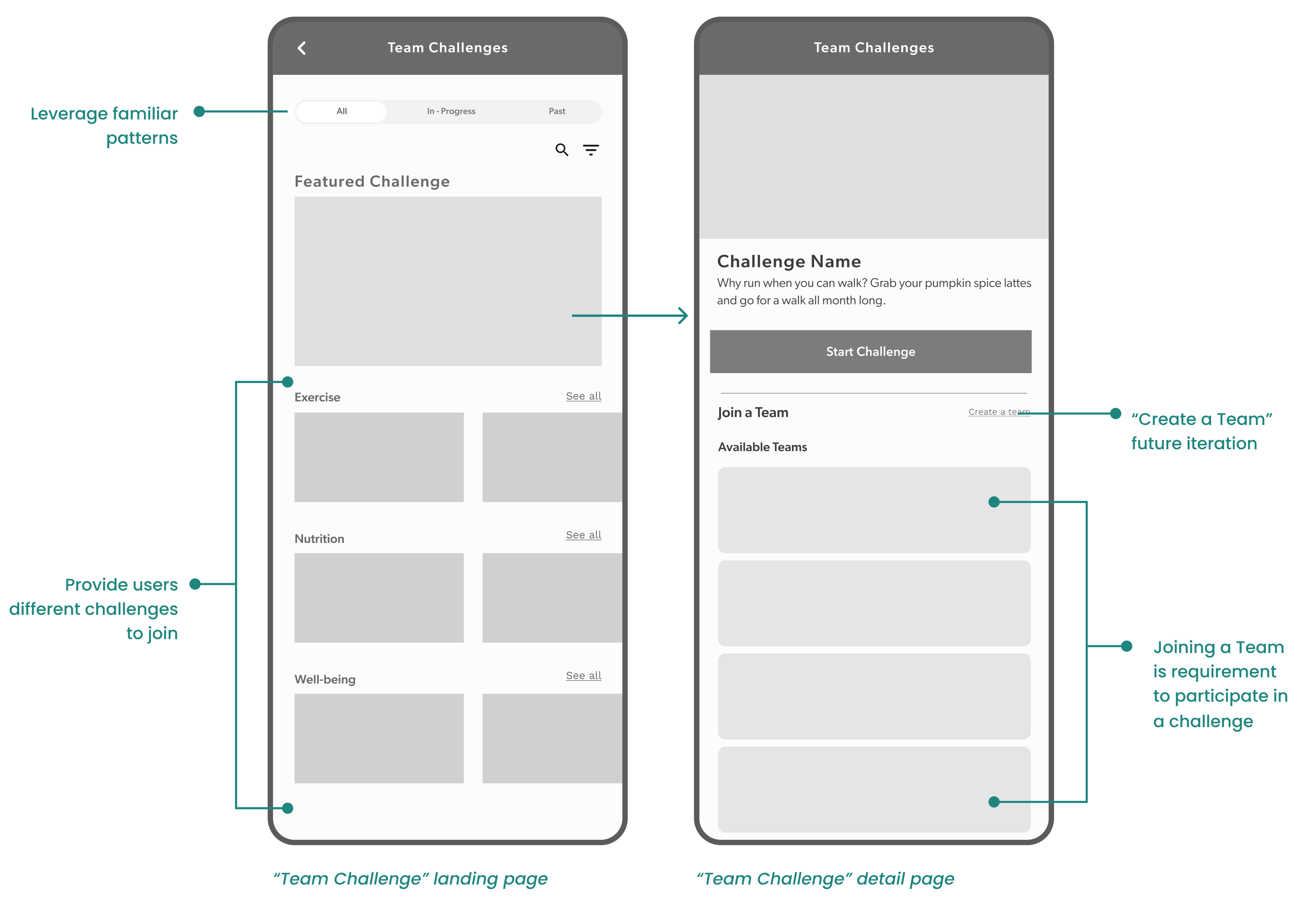
IDEATION
Iteration & Feedback
Throughout my progress, I presented multiple rounds of iteration to stakeholders. I continuously progressed towards higher fidelity wireframes and testing through rapid prototyping. This process really helped define the design through real feedback.
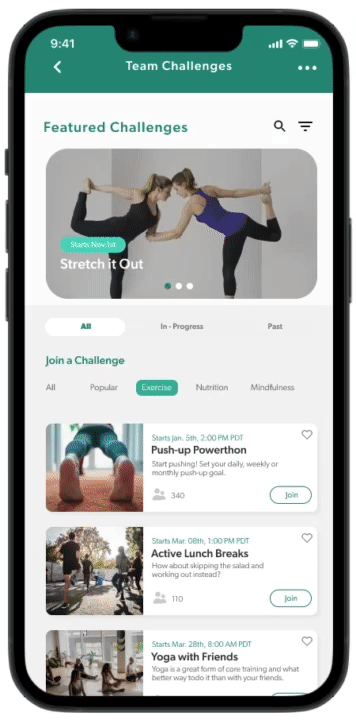
Final Solution
Ultimately, we introduced Teams to the Keas app. The logic was that users could gather more points by becoming more active through participating on as many teams as they wanted to. A user accumulated more points by joining more teams, which we leveraged to engage the user.
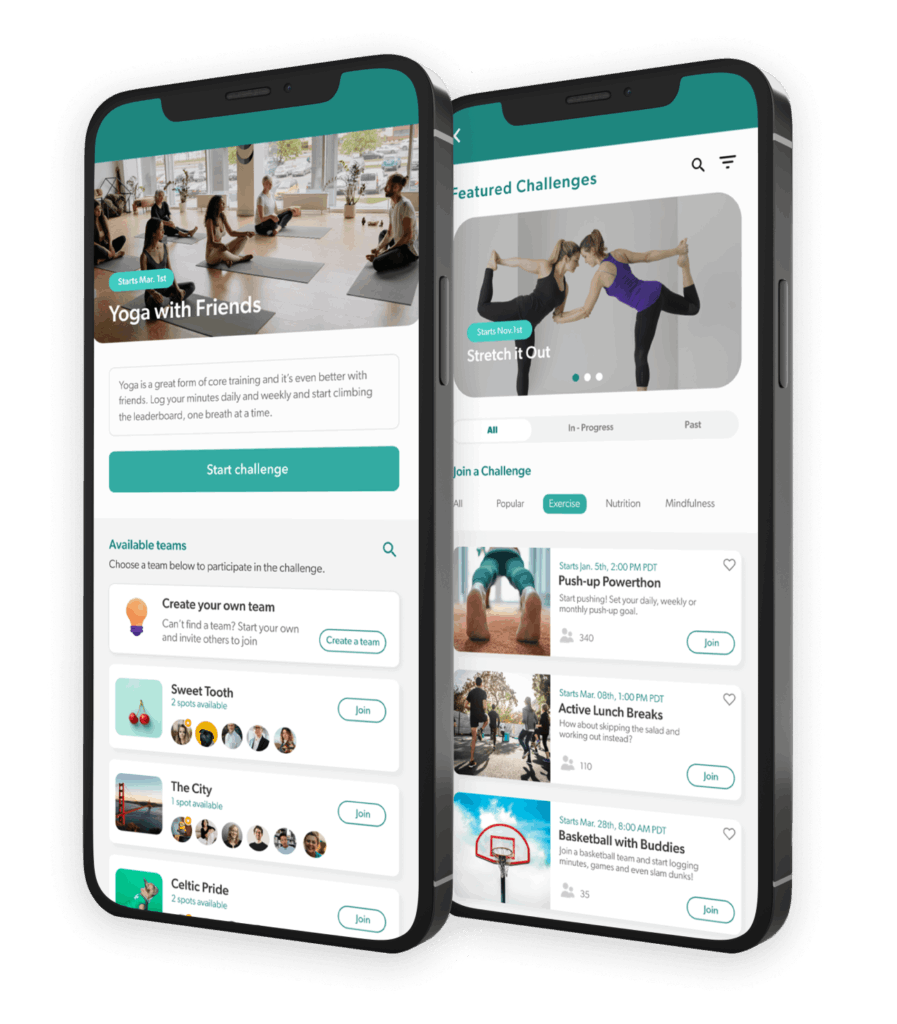
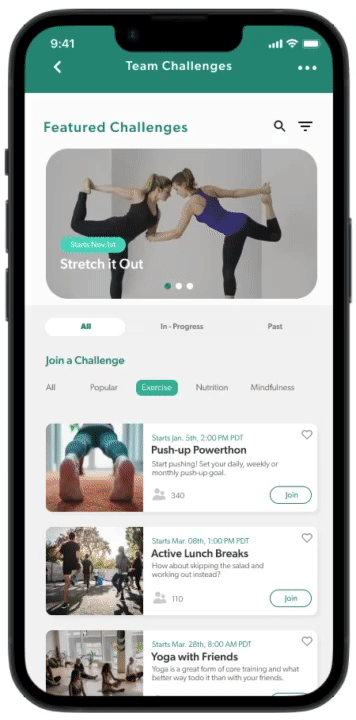
SOLUTION
Team Challenges
“Team Challenges” was the primary point for increased user engagement. This new feature allowed users to join multiple teams and compete with other teams within a specific set challenge.
SOLUTION
Interactive Leaderboards
Another feature that helped promote social engagement were interactive leaderboards. The new leaderboard provided users access to other user profiles as well as messaging among them.
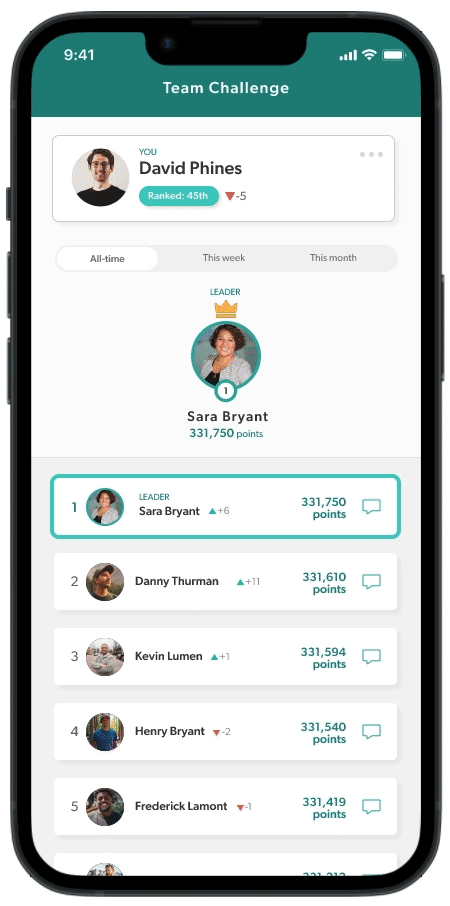
SOLUTION
Reflections / Takeaways
No such thing as perfect
Did the new feature solve all of Keas’ user engagement issues? Probably not, but we did have success metrics that indicated improvement. The first quarter release, the new “Team Challenge” feature contributed to a 49% increase on time spent on the app. Typical users went from 4m 31s to 6m 12s for time on app.
Getting to know thy user
I believe that one of the most important stages of my process was in early user research. Really understanding the user pain points from a qualitative perspective, provided key insights for me and the team to find a solution. Being one of my first full-cycle projects, this stage taught the importance of users and their needs.
Room for growth
One of the more important outcomes of this project was the opportunity to expand on the feature. The new social enhancements, opened doors to possible new features. During my final months at Keas we had began exploration around health devices, video as well as partnering with other health apps.

